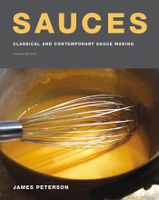Advertisement
Improvising White Sauces
Appears in
Published 1991
In real-life situations, a saucier is likely to use a combination of methods to prepare a particular sauce, rather than adhering rigidly to one technique at a time. The methods presented in this chapter represent extremes within a range of possibilities. Each technique has its advantages and disadvantages and must often be adapted to a particular situation. Classic sauces made with flour are relatively inexpensive to prepare, but often have a muted quality that modern diners (and chefs) eschew. Butter-enriched white sauces are delicious but require an enormous amount of stock because the stock must be reduced anywhere from six to fifteen times, to a demi-glace, for it to have the natural consistency that these sauces require. This time-consuming reduction is often impractical in all but the most expensive restaurants. Reduced-cream sauces are also delicious, but they are extremely rich and, like butter-enriched sauces, require large amounts of reduced stock. Classic versions are less expensive to prepare but will often taste flat to diners accustomed to flourless sauces.

